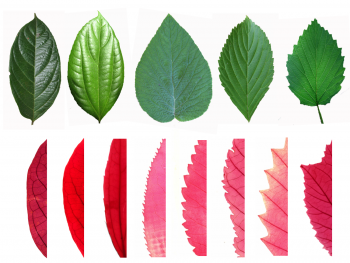 In collaboration with Erika Edwards and her lab at Brown University, we are currently funded by the NSF (IOS-1256706) to investigate the evolution of leaf form in Viburnum and how traits such as leaf teeth are related to the way that leaves are packed inside of resting buds. This project is a continuation of work completed under a previous NSF award (IOS-0842800) to study Viburnum leaf form (Lawren Sack of UCLA also served as Co-PI).
In collaboration with Erika Edwards and her lab at Brown University, we are currently funded by the NSF (IOS-1256706) to investigate the evolution of leaf form in Viburnum and how traits such as leaf teeth are related to the way that leaves are packed inside of resting buds. This project is a continuation of work completed under a previous NSF award (IOS-0842800) to study Viburnum leaf form (Lawren Sack of UCLA also served as Co-PI). A global pattern in leaf form has long been recognized: leaves in tropical climates have smooth margins while plants living in cold regions have leaves with teeth or lobes. This relationship is so strong that paleobotanists use leaf form in fossil floras as a proxy for temperature, allowing estimates of climate change through time. But, we still lack a general mechanistic understanding of why this relationship exists. We hypothesize that the evolution of complex leaf margins in temperate plants results in part from the way that immature leaves are packed into overwintering buds. This is inspired by recent mathematical models of efficient leaf folding within buds, and also by observations of within-plant differences in leaf form that relate to the rhythm of shoot growth.
It appears that there have been multiple shifts between tropical and temperate forests during the evolution of Viburnum, a widespread lineage of ~170 species of shrubs and trees. These biome shifts have been accompanied by the expected changes in leaf shape. We are documenting the timing of growth, leaf lifespan, and patterns of leaf packing within buds, and gathering additional data on relevant morphological and physiological traits on a set of Viburnum species spanning the tropical-temperate gradient. We are also continuing long-term phenological monitoring of ~30 Viburnum species at the Arnold Arboretum in Boston, Massachusetts. This is a highly collaborative and interdisciplinary project, involving biologists from Japan, Taiwan, China, and Malaysia, as well as applied mathematicians. We also plan to develop educational modules for elementary school children aimed to bridge the gap between math and biology, using origami and basic geometric principles to understand common leaf shapes.
Schmerler, S., W. Clement, J. Beaulieu, D. Chatelet, L. Sack, M. J. Donoghue, and E. Edwards. 2012. Evolution of leaf form correlates with tropical-temperate transitions in Viburnum (Adoxaceae). Proceedings of the Royal Society B 279:3905-13. doi:10.1098/rspb.2012.1110.
Chatelet, D. S., W. Clement, L. Sack, M. J. Donoghue, and E. J. Edwards. 2013. The evolution of photosynthetic anatomy in Viburnum (Adoxaxeae). International Journal of Plant Sciences 174(9):1277-1291.
Edwards, E. J., D. Chatelet, L. Sack, and M. J. Donoghue. 2014. Leaf life span and the leaf economic spectrum in the context of whole plant architecture. Journal of Ecology 102:328–336.